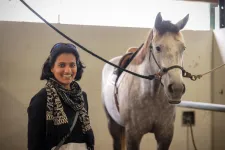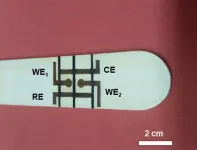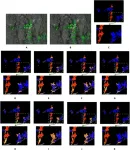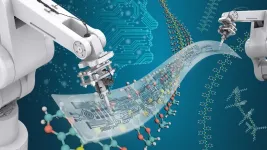(Press-News.org) Humans and horses have enjoyed a strong working relationship for nearly 10,000 years — a partnership that transformed how food was produced, people were transported and even how wars were fought and won. Today, we look to horses for companionship, recreation and as teammates in competitive activities like racing, dressage and showing.
Can these age-old interactions between people and their horses teach us something about building robots designed to improve our lives? Researchers with the University of Florida say yes.
“There are no fundamental guiding principles for how to build an effective working relationship between robots and humans,” said Eakta Jain, an associate professor of computer and information science and engineering at UF’s Herbert Wertheim College of Engineering. “As we work to improve how humans interact with autonomous vehicles and other forms of AI, it occurred to me that we’ve done this before with horses. This relationship has existed for millennia but was never leveraged to provide insights for human-robot interaction.”
Jain, who did her doctoral work at the Robotics Institute at Carnegie Mellon University, conducted a year of field work observing the special interactions among horses and humans at the UF Horse Teaching Unit in Gainesville, Florida. She will present her findings today at the ACM Conference on Human Factors in Computing Systems in Hamburg, Germany.
Like horses did thousands of years before, robots are entering our lives and workplaces as companions and teammates. They vacuum our floors, help educate and entertain our children, and studies are showing that social robots can be effective therapy tools to help improve mental and physical health. Increasingly, robots are found in factories and warehouses, working collaboratively with human workers and sometimes even called co-bots.
As a member of the UF Transportation Institute, Jain was leading the human factor subgroup that examines how humans should interact with autonomous vehicles, or AVs.
“For the first time, cars and trucks can observe nearby vehicles and keep an appropriate distance from them as well as monitor the driver for signs of fatigue and attentiveness,” Jain said. “However, the horse has had these capabilities for a long time. I thought why not learn from our partnership with horses for transportation to help solve the problem of natural interaction between humans and AVs.”
Looking at our history with animals to help shape our future with robots is not a new concept, though most studies have been inspired by the relationship humans have with dogs. Jain and her colleagues in the College of Engineering and UF Equine Sciences are the first to bring together engineering and robotics researchers with horse experts and trainers to conduct on-the-ground field studies with the animals.
The multidisciplinary collaboration involved expertise in engineering, animal sciences and qualitative research methodologies, Jain explained. She first reached out Joel McQuagge, from UF’s equine behavior and management program who oversees the UF Horse Teaching Unit. He hadn’t thought about this connection between horses and robots, but he provided Jain with full access, and she spent months observing classes. She interviewed and observed horse experts, including thoroughbred trainers and devoted horse owners. Christina Gardner-McCune, an associate professor in UF’s department of computer and information science and engineering, provided expertise in qualitative data analysis.
Data collected through observations and thematical analyses resulted in findings that can be applied by human-robot interaction researchers and robot designers.
“Some of the findings are concrete and easy to visualize, while others are more abstract,” she says. “For example, we learned that a horse speaks with its body. You can see its ears pointing to where something caught its attention. We could build in similar types of nonverbal expressions in our robots, like ears that point when there is a knock on the door or something visual in the car when there’s a pedestrian on that side of the street.”
A more abstract and groundbreaking finding is the notion of respect. When a trainer first works with a horse, he looks for signs of respect from the horse for its human partner.
“We don’t typically think about respect in the context of human-robot interactions,” Jain says. “What ways can a robot show you that it respects you? Can we design behaviors similar to what the horse uses? Will that make the human more willing to work with the robot?”
Jain, originally from New Delhi, says she grew up with robots the way people grow up with animals. Her father is an engineer who made educational and industrial robots, and her mother was a computer science teacher who ran her school’s robotics club.
“Robots were the subject of many dinner table conversations,” she says, “so I was exposed to human-robot interactions early.”
However, during her yearlong study of the human-horse relationship, she learned how to ride a horse and says she hopes to one day own a horse.
“At first, I thought I could learn by observing and talking to people,” she says. “There is no substitute for doing, though. I had to feel for myself how the horse-human partnership works. From the first time I got on a horse, I fell in love with them.”
END
How a horse whisperer can help engineers build better robots
2023-04-25
ELSE PRESS RELEASES FROM THIS DATE:
Say ‘ahhh’: This ecofriendly tongue depressor checks vitals
2023-04-25
Doctors often use tongue depressors when peering in a patient’s mouth and throat. But what if that flat wooden spatula could actively evaluate the patient’s health? That’s the premise of an ecofriendly disposable sensor, reported in ACS’ Analytical Chemistry, that can check levels of glucose and other biomarkers in saliva. Researchers say the easy-to-produce device could someday help doctors assess a range of conditions.
Wood is a renewable, biodegradable, natural material that is widely available at low cost, which makes it attractive for researchers who design electronics and sensors. However, this is challenging because the material isn’t good ...
Biomarker pattern found in kids with COVID 19-linked inflammatory syndrome
2023-04-25
WHAT:
Children with multisystem inflammatory syndrome (MIS-C)—a rare condition linked with the virus that causes COVID-19—have biochemical indicators of cell injury and cell death that are distinct from other children with COVID-19, according to a study funded by the National Institutes of Health. Using high speed, artificial intelligence-controlled molecular sequencing of blood-and-plasma RNA and plasma DNA, researchers found that children with MIS-C have biomarkers indicating damage to multiple organs, the lining of blood vessels and the nervous system. MIS-C usually occurs two to six weeks after ...
Charles Spruck awarded $1.7M to advance “ancient virus” treatment for prostate cancer
2023-04-25
LA JOLLA, CALIF. April 25, 2023 - With the help of a new grant from the U.S. Department of Defense for more than $1.7 million, Associate Professor Charles Spruck, Ph.D., will advance an innovative therapeutic approach for metastatic prostate cancer. Known as viral mimicry, the approach tricks the body into thinking that it has a viral infection, stimulating an immune response that can help the body fight cancer.
“In viral mimicry, the body thinks there’s an infection, which kicks the ...
New motion blur restoration approach for improved weed detection in crop fields
2023-04-25
Effective weed control is crucial in agriculture to ensure high crop productivity. It entails the careful separation of weeds from crops before herbicides are sprayed in the fields. In simple terms, the goal of weed control is to remove the weeds while ensuring that the crop are not harmed. Traditional weed control methods have several drawbacks, such as crop contamination, herbicide waste, and poor accuracy. Therefore, it is essential to develop methods that can precisely locate and identify the boundary between a crop and weed and implement ...
Argonne’s self-driving lab accelerates the discovery process for materials with multiple applications
2023-04-25
Researchers have a new scientific tool called Polybot, combining the power of artificial intelligence with robotics. Potential applications include speeding up the discovery of wearable biomedical devices, materials for better batteries and more.
Today’s wearable technologies like smart glasses and watches are just the start. The next generation of flexible electronics will be more efficient and sustainable, better able to monitor our health and treat certain diseases, and much more. They will be composed of electronic polymer materials — a soft pliable substance that can conduct electricity.
“Just imagine the next generation of polymer ...
Champion for improved perioperative care for older adults: Shelley R. McDonald, DO, PhD, MCG honored as AGS Clinician of the Year
2023-04-25
New York (April 25, 2022) — The American Geriatrics Society (AGS) today announced Shelley R. McDonald, DO, PhD, MCG, as 2023 Clinician of the Year. Dr. McDonald, who is an Associate Professor of Internal Medicine at Duke University School of Medicine, will be honored at the 2023 AGS Annual Scientific Meeting (#AGS23) being held in Long Beach, CA, from May 4-6 (preconference day is May 3).
“Our 2023 Clinician of the year, Dr. Shelley McDonald, is a national champion for improved perioperative care of older adults undergoing surgery,” said ...
RCT-DUPLICATE findings demonstrate capability of real-world evidence studies to reach conclusions similar to randomized clinical trials
2023-04-25
NEW YORK, April 25, 2023 ‒ Aetion®, the global leader in real-world evidence (RWE) technology and analytics, is pleased to announce the culmination of the RCT-DUPLICATE demonstration project, with complete findings published today in The Journal of the American Medical Association (JAMA). This three-year initiative tested whether researchers asking clinical questions in real-world data (RWD) — data from patients’ day-to-day interactions with the healthcare system — would obtain similar results to findings from randomized clinical trials (RCTs). In cases where clinical trial designs aligned with real patient care processes, the RWE studies and RCTs came ...
Exposure to cannabinoids in pregnancy increases newborn mortality and respiratory problems
2023-04-25
Consumption of cannabis (marijuana) or derivatives during pregnancy can cause respiratory problems for the baby, such as impaired control of breathing and diminished sensitivity to carbon dioxide, both of which favor sudden infant death syndrome. These are the main findings of a study conducted in Brazil and reported in an article published in the British Journal of Pharmacology.
The authors are researchers at São Paulo State University (UNESP) and the University of São Paulo (USP). They gave pregnant rats a synthetic compound (WIN 55) that acts on the brain in a similar manner to natural cannabinoids. Harmful effects occurred mainly in male pups.
“Cannabis ...
Matching form and function of brain cell types
2023-04-25
Investigators at Cedars-Sinai have created computer-generated models to bridge the gap between “test tube” data about neurons and the function of those cells in the living brain. Their study, published in the peer-reviewed journal Nature Communications, could help in the development of treatments for neurological diseases and disorders that target specific neuron types based on their roles.
“This work allows us to start looking at the brain like the complex machine that it is, rather than ...
Small steps can yield big energy savings and cut emissions from MRIs
2023-04-25
Medical centers around the world could significantly reduce their carbon footprint and expenses by turning off MRIs and putting them in the lowest power mode instead of idling them when not in use, a new study in Radiology found.
Health care is responsible for up to 4.4% of global carbon emissions, and imaging contributes an outsized share due to its energy-intensive devices, especially MRI. A 2020 study found that three CTs and four MRIs used the same amount of energy per year as a town of 852 people, for example.
Though turning a machine off is better than idling, a substantial amount of MRI energy consumption occurs in “off” ...






